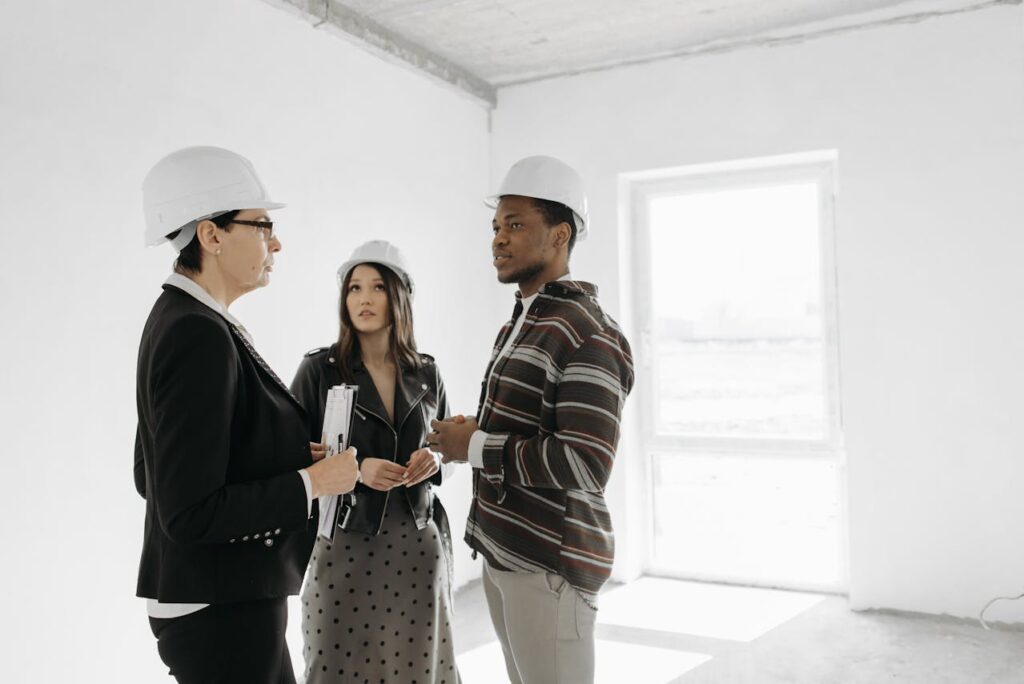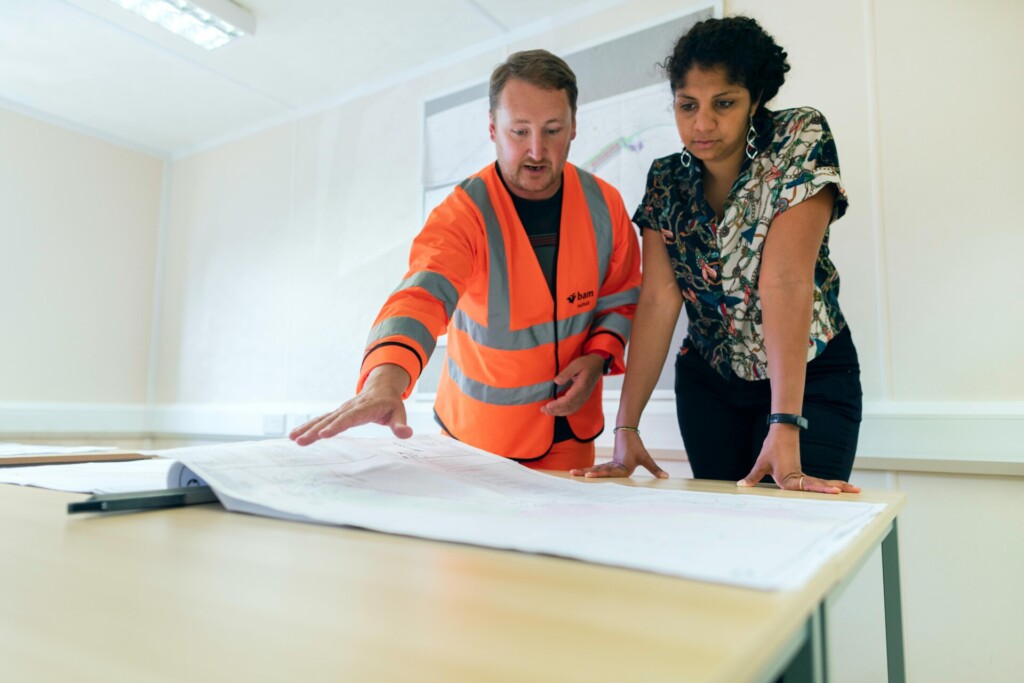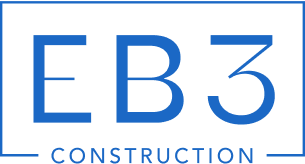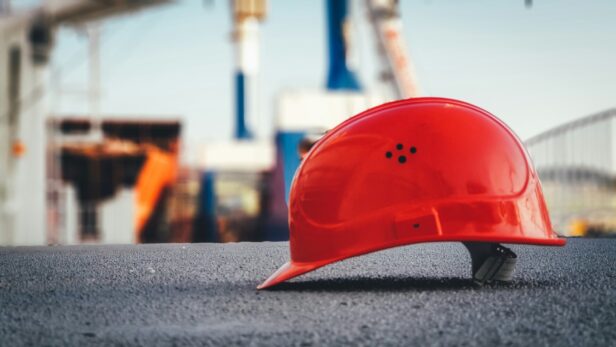A commercial build-out transforms an empty shell or previously occupied space into a functional workspace tailored to tenant needs. This process involves interior construction work that makes raw commercial space ready for business operations.
We coordinate this transformation through tenant improvements, which encompass everything from framing walls and installing electrical systems to applying finishes and configuring HVAC systems. The scope typically includes structural modifications, building system upgrades, and interior design elements that create a professional environment suited to specific business requirements.
How Does A Commercial Build-Out Move From Lease To Handover?

Commercial build-outs follow a structured sequence from initial lease signing to final occupancy. Each phase builds on the previous one, requiring precise coordination among all stakeholders to avoid delays and cost overruns.
Lease Negotiations Set The Foundation
The build-out process begins before construction starts. We define the scope of improvements and establish who manages the work during lease negotiations. This phase determines whether the tenant or landlord will oversee the project and coordinate with contractors.
Negotiating a tenant improvement allowance becomes critical at this stage. The TIA establishes the financial framework for the entire project, typically expressed as dollars per square foot or a lump sum amount. We secure these terms in writing within the lease agreement to prevent disputes later.
Design And Test Fit Establish Project Parameters
Once the lease is signed, the architect and contractor assess the existing space conditions. We conduct site surveys to identify existing mechanical, electrical, and plumbing systems that can be reused or require modification. This assessment directly impacts both budget and schedule.
The test-fit plan serves as the project’s blueprint. We create preliminary layouts that show how the space will function for the tenant’s specific operations. This phase includes determining wall locations, door placements, and system requirements before detailed design begins.
Construction documents follow the approved test-fit plan. These detailed drawings specify materials, finishes, and technical requirements for all building systems. We use these documents for permit applications and contractor bidding to ensure accurate pricing and compliance.
Permits And Zoning Approvals Clear Legal Requirements
Most commercial build-outs require city permits before construction can begin. We submit applications that include architectural drawings, structural calculations, and system specifications. The complexity of the project determines which permits are needed.
Typical permitting takes about 6 to 8 weeks, depending on jurisdiction and timing. Urban areas with high construction activity often experience longer review periods. We factor these timelines into project schedules to avoid delaying the tenant’s move-in date.
Zoning approvals ensure the intended use complies with local regulations. We verify that the proposed tenant type and occupant load meet zoning requirements for the building’s location. This step prevents costly modifications after construction begins.
Construction Transforms The Space
The construction phase begins with demolition of prior tenant improvements that don’t align with the new design. We carefully remove outdated systems and finishes while protecting building infrastructure that will remain.
Framing and drywall installation create the new spatial layout. We build partition walls, door frames, and ceiling structures according to the approved plans. This work establishes the basic room configurations and circulation patterns.
MEP systems installation follows the framing work. We route new electrical circuits, plumbing lines, and HVAC ductwork before closing walls. Technology accommodations for data, security, and communication systems are integrated during this phase.
Finish work includes painting, flooring installation, and millwork. We coordinate these trades carefully to maintain quality and prevent damage to completed work. Ceiling installation and lighting complete the interior environment.
Punch List And Closeout Ensure Quality Completion
We conduct a comprehensive walk-through of the space as construction nears completion. This inspection identifies deficiencies that need correction before the tenant occupies the space. Items might include paint touch-ups, hardware adjustments, or system calibration.
The punch list documents all identified issues with specific locations and required corrections. We track completion of each item and verify the work meets project standards. No item is considered complete until it passes final inspection.
Final walk-through occurs after all punch list corrections are complete. We verify that all systems operate properly and the space meets the original specifications. This step triggers the official handover from contractor to tenant.
The closeout process includes delivering warranties, operation manuals, and as-built drawings to the tenant. We ensure all permits receive final approval and certificates of occupancy are issued. Only then can the tenant legally occupy the completed space.
What Build-Out Delivery Options Can Tenants Choose?
Tenants can select from two primary delivery approaches that fundamentally differ in control, responsibility, and cost coverage. Each approach offers distinct advantages depending on project complexity, timeline requirements, and your team’s construction experience.
Tenant Build-Out Approach
With tenant build-out, you assume direct responsibility for the entire construction process. You hire and manage the architect, engineer, and contractor while coordinating all aspects of the project timeline.
This approach offers maximum control over contractor selection, material specifications, and construction quality. You negotiate directly with subcontractors and can make real-time decisions about design changes or material upgrades during construction.
The tenant typically negotiates a tenant improvement allowance from the landlord to cover construction costs. However, you remain financially responsible for any cost overruns beyond the agreed allowance amount.
Budget management becomes your responsibility, requiring careful oversight of construction expenses and change orders. While this creates financial risk, it also allows you to capture any cost savings if the project comes in under budget.
Turnkey Build-Out Approach
Under a turnkey arrangement, the landlord delivers a move-in ready space according to predetermined specifications. The landlord manages the entire construction process and covers all renovation costs.
This approach eliminates your need to hire or coordinate with construction professionals. The landlord handles contractor selection, permitting, and project management while you focus on your core business operations.
Cost predictability represents a major advantage since the landlord absorbs budget overruns and construction delays. You receive a finished space without additional financial exposure beyond your lease obligations.
Quality control requires attention during lease negotiations. We recommend establishing specific quality standards and requiring landlord approval of the general contractor to prevent the use of low-quality materials or substandard workmanship.
Clear specifications must be documented in the lease agreement to avoid disputes over finish levels, fixture quality, or construction standards. Without detailed requirements, landlords may deliver basic finishes that don’t meet your operational needs.
The choice between these approaches depends on your available resources, construction expertise, and risk tolerance. Tenant build-out suits organizations with project management capabilities and specific design requirements, while turnkey delivery works well for businesses prioritizing simplicity and cost certainty.
Who Is Involved In A Build-Out And What Must They Coordinate?

Commercial build-outs require multiple professionals working together to transform raw space into functional tenant areas. Each professional handles specific responsibilities while maintaining constant communication with other team members. We work with these same professionals on every build-out project to ensure seamless coordination.
Core Design And Planning Team
The architect leads the design process by creating space layouts that meet tenant needs and building codes. They produce detailed construction documents that guide all other professionals. Architects also secure permits from local agencies and ensure the design complies with accessibility requirements.
Interior designers work alongside architects to specify finishes, fixtures, and furnishings. They coordinate color schemes, lighting design, and space functionality. Designers help tenants make informed decisions about materials that balance aesthetics with budget constraints.
Construction And Technical Specialists
The general contractor manages all construction activities and coordinates subcontractors. They provide technical advice on plumbing routes, HVAC capacity, and electrical power requirements. Contractors also handle scheduling, material procurement, and quality control throughout the build-out.
Project engineers review structural modifications and building system integration. They ensure mechanical, electrical, and plumbing systems work within existing infrastructure. Engineers also verify that all installations meet current building codes and safety standards.
Essential Coordination Requirements
Landlord coordination involves reviewing construction documents and approving tenant modifications. Property owners must grant access to building systems and coordinate with existing tenants. They also verify that all work meets lease requirements and building standards.
Tenant coordination requires regular communication about design decisions and timeline updates. Occupants need to approve material selections, space layouts, and system specifications. We schedule regular progress meetings to keep tenants informed and address concerns quickly.
Permit coordination involves submitting applications to multiple agencies and tracking approval timelines. The team must coordinate inspections with city officials and address any code compliance issues. This process typically requires 6-8 weeks and affects the overall project schedule significantly.
What Should Tenants Consider And Who Pays For The Build-Out?
Successful build-outs require careful consideration of space requirements and clear understanding of financial responsibilities. We’ve found that tenants who address these factors early avoid costly changes and delays during construction.
Key Build-Out Considerations
Space planning forms the foundation of any effective build-out. Define each space type clearly, including offices, reception areas, conference rooms, break rooms, warehouse sections, and restrooms. Each area serves specific functions and requires different finishes, lighting, and mechanical systems.
Occupant load calculations drive many code requirements. Size restrooms, egress paths, and HVAC capacity based on expected occupancy. Building codes mandate specific ratios for restroom fixtures and exit widths that vary by occupancy type and total capacity.
Finish levels significantly impact both budget and timeline. Standard-grade finishes like basic carpet and paint cost substantially less than premium materials. We typically recommend prioritizing high-traffic and client-facing areas for upgraded finishes while using cost-effective options in back-of-house spaces.
Mechanical systems planning saves money and prevents complications. Electrical power, plumbing, and HVAC modifications should be designed around existing infrastructure whenever possible. Adding new circuits or plumbing runs increases costs dramatically compared to working within existing capacity. Early coordination with building engineers helps identify available capacity and connection points.
HVAC coverage requires specific attention during lease negotiations. Some landlords provide basic heating and cooling while others expect tenants to handle all climate control costs. We often see tenants surprised by monthly HVAC charges that can be amortized into rent or negotiated as part of operating expenses.
Realistic scheduling prevents rushed decisions and cost overruns. Build-out timelines depend on permit complexity, contractor availability, and scope of work. We typically see simple office renovations taking 8-12 weeks while complex restaurant or medical fit-outs require 16-20 weeks from permit submission to occupancy.
Who Pays For Build-Out Costs
Build-out costs are typically shared between landlord and tenant through negotiated arrangements. The most common structure is a tenant improvement allowance expressed as dollars per square foot of leased space. Allowances typically range from $20 to $60 per square foot depending on building class, lease term, and market conditions.
Landlords generally fund improvements that add permanent value to the property. This includes framing, drywall, basic electrical and plumbing, standard flooring, and HVAC modifications. These improvements remain with the building and benefit future tenants.
Tenants typically pay for specialized equipment, custom millwork, upgraded finishes beyond building standards, and technology infrastructure specific to their operations. Business-specific improvements like specialized lighting or equipment connections usually fall outside standard allowances.
Cost responsibility should be clearly defined in lease terms. We recommend detailed schedules that specify which party handles each improvement category. Ambiguous language leads to disputes during construction when both parties assume the other is covering specific costs.
Successful negotiations balance tenant needs with landlord investment recovery. Longer lease terms often justify higher allowances since landlords have more time to recoup their investment. Strong tenant creditworthiness also supports larger allowance requests by reducing landlord risk.
Conclusion and Next Steps

A commercial build-out transforms existing space into a functional tenant environment while meeting local codes and lease requirements. We manage this process by coordinating between all parties and ensuring compliance at every stage. The foundation for success lies in early planning and clear communication among stakeholders.
Define your space requirements before signing the lease. Secure a test fit and preliminary budget from qualified professionals. Negotiate tenant improvement allowance terms that align with your actual construction costs. Plan for permit timelines that can extend 6-8 weeks depending on your jurisdiction. Track punch-list items systematically to avoid delays at closeout. We coordinate with architects, engineers, landlords, and tenants to deliver spaces that meet safety standards and operational needs.
Ready to start your commercial build-out project? Contact EB3 Construction to discuss how we can help transform your space.




